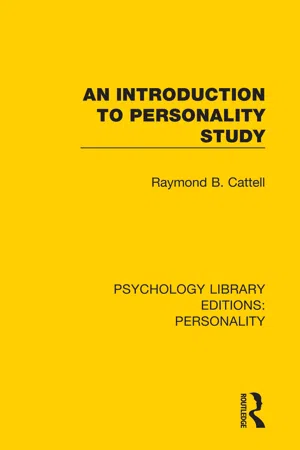1. AGE CHANGES IN PHYSICAL AND MENTAL ABILITIES
THE studies of the preceding chapters concerning the description, structure, formation processes, and physical, hereditary and cultural influences in regard to personality have equipped us to attempt a culminating review of these in the setting of longitudinal development. The development of personality through the life span is, in fact, the most interesting and instructive of aspects, but it could not be appreciated until basic cross-sectional analyses of personality in being had been completed.
It has become a convention in psychology to section development into separate studies of child psychology, adolescence, maturity and the psychology of old age, and we shall give brief attention to each of these periods as such, but at first it is more rewarding to study the rise and decline of certain psychological functions through the whole life span. Let us desist, therefore, from quoting Shakespeare on the seven ages of man, or any other breakdown into periods, and view change first as a continuous curve.
Since the effects of the physical condition of the organism on personality have been demonstrated to be far from insignificant, it is necessary to glance first at the facts regarding physique and age. General, and especially muscular growth shows an acceleration at adolescence when the secondary sex characteristics manifest themselves also in changing bodily proportions and fat deposition; growth in weight, moreover, continues beyond the flattening of the height curve at about 18. The head goes on growing slightly in size and changing in bony shape,right through maturity to middle age. In woman, and more slowly and less severely in men, the general adolescent changes tend to be reversed in middle age; in old age there is a characteristic muscular and general physical shrinkage, accompanied by circulatory inefficiency and lowered metabolic rate.
Simple performances of speed and muscular strength show a smooth, rapid rise from birth to the middle twenties, followed by a slow decline, somewhat hastened after 45. If one compares with these statements about the average man the records by the outstanding performers in athletics and sports he finds a corroborative picture. Buhler found that the age of champions was, in sprint and long jump 23, long distance running 25, and tennis 28; while Wynn Jones found that in slower, more ‘strategic’ games the age was somewhat higher, namely, 31 in golf and 34 in cricket. Some of the simplest, single physical performances reach their maximum surprisingly early. In visual powers, and hearing, for example, ‘senility’ begins to set in from the age of about 18!
Turning to more general abilities we find, first, a trend in intelligence test measures which conflicts somewhat with popular notions but is too clear cut and experimentally well established to be doubted. This shows a rapid increase of general ability up to 14, a slow rise thence to a plateau from about 18 to 24 and thereafter a very slow decline, such that, by the age of 55 the level is back to about 14, as in Diagram XIX. This refers, of course, to ability apart from knowledge. Lorge (7), an associate of Thorndike, using the latter’s intelligence test, showed, however, that if intelligence tests be given without a time limit, so that sheer difficulty and not quickness of thinking be involved, there is no demonstrable decline1 after 20 and the curves keep on as shown in the intermittent line in Diagram XIX.
Ability to memorize or learn has been considered to decline rather rapidly, according to the adage ‘you cannot teach an old dog new tricks’. But actual investigations show that if we take the age of 16 as constituting our 100 per cent learning standard middle-aged people (35 to 60) show from 70 to 100 per cent of that capacity, in most of the varieties of learning material studied, e.g. learning new languages, new motor habits, etc. Sheer modifiability, in which past learning does not help (as in disposition rigidity), is most affected by age. Even at 80 the true learning capacity still hovers between 45 and 85 per cent of the 16 year level. The reason that older people seldom learn new material seems to be lack of motive and interest rather than lack of capacity. However, we must bear in mind that though ‘It is never too late to learn’, learnin...
